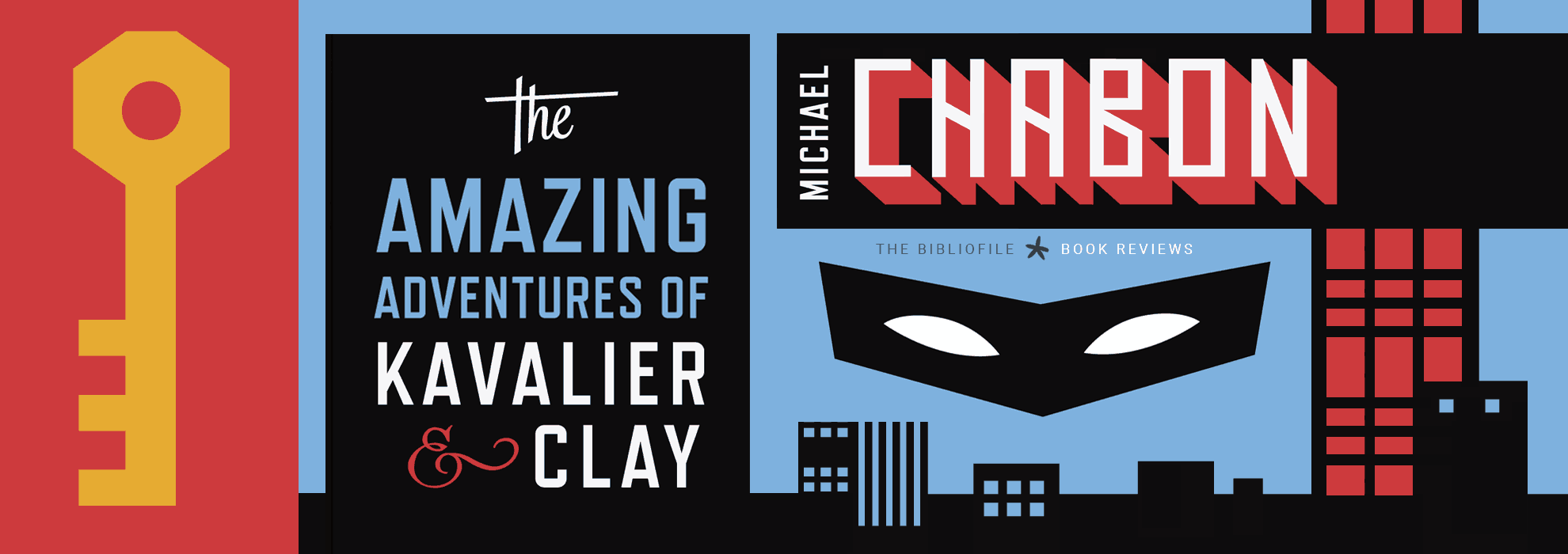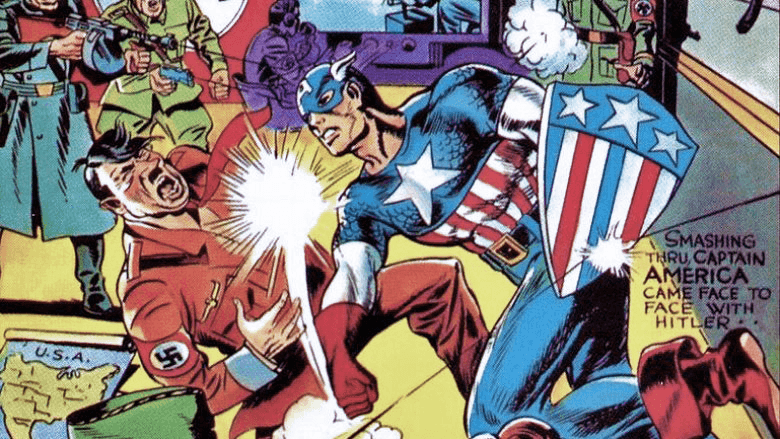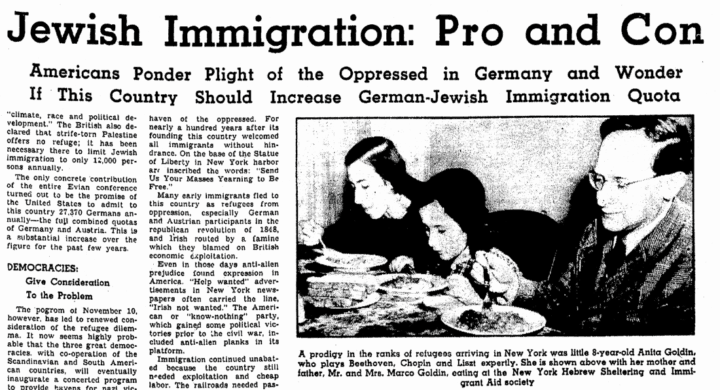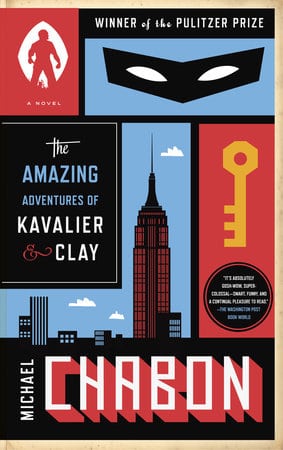There’s been chatter lately from certain outlets about how comic books are being ruined by social justice warriors (or “SJW”s for short) who are making these stories too “political”. It’s ironic for a number of reasons — one of which is that the modern day superhero has a storied history of being a social justice symbol.
Anyway, it prompted me to finally finish The Amazing Adventures of Kavalier and Clay, which I’ve started and stopped a few times. For a while, a lot of people cited it as their favorite book, but it seems to have drifted off from popularity for some time now. At any rate, originally published in September 2000, it’s set around the time when comic book heroes began to be popularized and is centered around a microcosm of that trend.
Plot Summary
The Amazing Adventures of Kavalier and Clay focuses on two cousins and their lives around the time of WWII. Joseph Kavalier is a Jewish teenager living in German-occupied Czechoslovakia before the war. Due to a fluke, he is the one member of his family eligible to emigrate to the United States.
With the assistance of his old mentor, a stage magician, he is smuggled out of the country in a crate containing a large Jewish relic, the Golem of Prague. He moves in with his aunt and his cousin, Sammy Clayman — or “Clay” for short, who works for a comic book publisher, but is troubled by thoughts of his family and the situation that he left behind.
Joe, an artist, and Clay, a writer, team up to develop a comic book series, and are tasked with creating a new superhero. Joe channels his frustrations into this character called the Escapist, who fights Nazis. On the cover of the first issue, the Escapist punches Hitler in the face. As the situation in Europe grow more dire, the Escapists feats against Nazis and the German army grow ever more impressive but violent. At the same time, Joe is fighting to find a way to have his younger brother brought over as well.
Historical Context and the Modern Comic Book Hero
It’s pretty clear that the book’s fictional Escapist hero is meant to be a literary stand-in for Captain America. Captain America was depicted punching Hitler in the face on the cover of the first issue (released about nine months prior to Pearl Harbor) and received heavy criticism as a result.
So, why read this book? Well, for starters, it tells a relatively obscure story about comic books and the rise of the modern comic book hero. Comic books exposed Americans to the atrocities leading up to and during the Holocaust, which was obviously an important social justice issue at the time.
By shining a light on the current events in Europe, early comic book heroes helped to shape the mores of those living in the United States which eventually led to the U.S. involvement in World War II. The idea of openly opposing the Nazis in war, while it seems obvious now, was controversial at the time. Joe faces a lot of pushback from his publisher about his very political stance.
It also uses its narrative yarn to loop in other aspects of the social justice struggles of pre-WWII America. Joe’s fight to have his 12-year-old brother, a Jewish refugee, sent over to the United States seems especially relevant now. While stories about refugees suffering or dying in transit trickle in, Joe faces roadblock after roadblock of bureaucrats with “antipathies” toward refugees.
It’s common to view the social justice battles where previous generations fought and prevailed as being part of the inevitable march of progress, while our own battles face much more skepticism and seem impossible. But how could we have been so cruel to Jewish people fleeing before WWII? Well, probably in much the same way we’re cruel and inhumane to refugees now.
In The Amazing Adventures of Kavalier and Clay, through the lives of two cousins living in Brooklyn, we get to revisit a part of history in a way that feels very lively and present. We’re also reminded of the difficulty of fighting the good fight, especially when it gets in the way of your personal ambitions.
“I’m tired of fighting, maybe for a little while. I fight, and I am fighting some more, and it just makes me have less hope, not more. I need to do something… something that will be great, you know, instead of trying always to be Good.”
“Joe, I–” Sammy started to argue, but just as quickly gave up. “Fine.” he said. “We’ll lay off the Nazis.”
Kavalier, Clay and the Classic Madonna-Whore Problem
It’s ironic, then, that my biggest gripe about this book is also a social justice issue: the representation of women. It is extremely insulting. The only female character with a significant role in this novel is Rosa Saks, a proto-typical manic pixie dream girl who is lying naked in a bed when we meet her. If this book were written today, she’d probably be depicted as the “Cool Girl” instead, but this was published in 2000.
Chabon’s novel exemplifies and takes to extreme the classic madonna-whore problem where every woman is either someone’s mother or she spends all her time naked and rolling around in bed. Nearly every female character that is not someone’s mother is literally naked or doing the dirty within the first few pages of meeting her. Even when clothed, the women in this novel spend a lot of time in the kitchen (sometimes they take a break to quarrel or cry about not being proposed to). There’s even a scene where Rosa is both partially dressed and cooking in the kitchen.
She lit a cigarette and walked into the kitchen in her underpants and brassiere, the bramble of her loosed hair flapping around her head like a crown of plumes.
In the kitchen she took out a saucepan, melted half a cup of butter, and thickened it with flour to a paste. To the paste she added milk, a little at a time, then sale, pepper, and onion powder…
Honestly, the situation here is bad, like really bad. The women are subservient and exist only to serve the men in their lives. Rosa quits her job and spends her time cooking for Joe, comforting Joe, sleeping with Joe and sometimes she paints pictures … of Joe. Like I said, it’s bad.
When tragedy strikes, Joe seeks comfort at his aunt’s house and doesn’t want to see Rosa. This makes sense, of course. After all, his aunt is the Madonna, and Rosa, our plucky maniac pixie dream girl, is obviously the whore.
Review
Even despite the glaring and very noticeable flaw in this book (which is why I originally stopped reading it in disgust), the The Amazing Adventures of Kavalier and Clay tells a unique story. It’s an epic story about comics, anti-Semitism, and stage magicians, and it touches upon the treatment of homosexuals as well.
From a literary perspective, I mean, it won the Pulitzer Prize for Fiction in 2001, so obviously the writing itself is solid. The set-up of the novel has a very epic comic-book novel feel to it too — complete with a backstory and even some villains! — which is a credit to Chabon’s ingenuity and creativity. The characters (well, really just the male ones) are richly drawn and complex.
A few themes crop up repeatedly — the idea that stories are powerful, even if somewhat fictionalized. It mentions again and again stories people tell that sound good or reinforce an idea but aren’t entirely accurate. There’s also the theme of escape and release — and its relationship with danger or even death.
Lively as it is though, the story didn’t have much of an emotional impact for me; I think it’s because I wasn’t very fond of the Joe Kavalier character, which the story really hinges on. The whole moody, depressed (somewhat self-centered) guy schtick with the maniac pixie love interest is a trope that hasn’t really aged well. It’s an eventful novel and there are parts that are imaginative and engrossing, but it didn’t come together as a whole for me. Towards the end, I had a hard time staying interested.
Read it or Skip it?
The book is certainly a colorful and thought-provoking read for anyone interested in this period of time. It’s lively and eventful, but lacked an emotional pull for me to feel invested in it’s sprawling narrative.
The depiction of women in this book really bothered me, to the extent that I am unable to give a hearty recommendation of it to anyone. I was surprised-slash-horrified that so few reviewers mentioned it or seemed to noticed. Sexism aside, the story it tells has it’s charms. I imagine whether you end up liking it or not will probably correlate with whether you identify with its main characters or not.
Have you read it or are you planning on reading it? What’d you think? Let me know your thoughts below!






Fascinating. I read it when it first came out in paperback, and similarly, did not feeling a strong emotional connection to the story. I do remember thinking it was well-written. It still sits on my bookshelf, though I’m not sure why. I far preferred “The Yiddish Policemen’s Union”, yet I traded that one in at my local bookstore.
When I read it I didn’t pick up on the, apparently blatant, sexism. Your review sort of makes me want to go back and read it again with fresh eyes, or maybe just remove it from my shelf.
Great review!
Hey, thanks for reading and for your thoughts! I think ten, fifteen years ago, women being over-sexualized or being portrayed in the kitchen was still more acceptable than it is today, to the extent that it seemed normal even to other women.
Sometimes I’m a little hesitant to revisit things that I used to love, knowing that viewing it with “fresh eyes” will most likely reveal some non-progressive attitudes I originally didn’t notice…
Definitely. Though I want to think I was always sensitive to those issues in literature, they were (and still are) a pervasive part of our culture. It is easy to believe I didn’t pick up on them the first time, or sadly, accepted them as an inevitable norm.
Great, critical review! I read this not too long after it came out, during a difficult period in my life, so I remember very little of it other than I found it harder to get through than I expected. I chalked that up to everything else that was going on, though. I’d be interested to give it a reread now, when I can devote more attention to it and read it with more years of critical experience behind me.
Thanks, Veronica! I had a tougher time getting through it than I thought I would too, actually — and yes, picking it back up after a lot of comments had been made about comics being too focused on social issues definitely made me look at it in a different light.
I read this a while back and thought it was okay. What I find funny is that I never thought of The Escapist as Captain America. But after reading your review I realized I didn’t see the obvious. To me I always thought of the Escapist as Superman. It has more to do with his creators Kavalier and Clay. I thought Chabon had based them on Superman’s creators Jerry Siegel and Joe Shuster. If I remember correctly the were Jewish. I got that thought early on in my head and just stuck with it.
Hey, thank you for your thoughts! Yeah, I definitely think Kavalier and Clay as a whole is a lot more than just the story of Captain America — I think it’s a story that’s meant to reflect the superhero industry as a whole during that Golden Age. Captain America seemed to me the closet analog to the Escapist character (since Superman already has a large, separate role in the book), but the characters of Kavalier and Clay could very well be analogs of Jerry Siegel and Joe Shuster. Based on the acknowledgements in the book, it sounds like he spoke to a lot of the “greats” of that era, so I have no doubt there’s a mix of elements in there!
Every time I try to visit things I use to love, I realize how sexist, racist and just overall trash they were. :( I just tell myself “it was a different time” and hope better for the future! Loved this review though and researched insight!
thank you! appreciate your thoughts — I think things are getting better, but I also think it’s important to point out problematic stuff because a lot of people don’t even realize their own deep-seated biases
An excellent review. I came across the book while cleaning out some old boxes of stuff. At first, I didn’t think I would read, much less enjoy, it. I had read Chabon’s novella, “The Parrot” and found it underwhelming. But I decided to give “Kavalier and Clay” a try and was surprised how gripping I found it. Maybe because I was a big fan of The Fantastic Four Comics when I was a kid. But I loved the storytelling and the details of the comic book industry at the time.
I agree with you about the depiction of women, though with a couple of caveats.
First, given that Joe and Sammy are the main characters, it is not surprising that there is more focus on them than other characters, including women. I have read many novels in which a woman (or women) were the main characters and the men in those stories played ancillary roles.
Second, I agree with you on the Madonna-Whore problem, as you call it. The sad reality is that, back in the period when the story takes place, that was often the situation. Have a look at these sexist ads from the 1960s. http://uk.businessinsider.com/26-sexist-ads-of-the-mad-men-era-2014-5?r=US&IR=T/#51-show-her-its-a-mans-world-2 Utterly shocking by today’s standards. I am glad that things have changed for the better in this regard, although there is still a ways to go before we have true equality between the sexes.
But again, an excellent review. I am glad to have discovered your site and will return. Cheers!
Hi, John, thank you for your comments! I actually also read Chabon’s novella (the Final Solution / Parrot book) but I found that story rather cute and charming, haha. To be fair though I read it a long time ago, so I don’t remember exactly why I liked it. It may have been because I didn’t know anything about Chabon at the time, so I had no expectations for it going in. If you read it after this book, I certainly imagine it would be underwhelming.
I think it’s fair that there’s not a focus on more female characters (I don’t think every story needs to throw in unnecessary female characters) — I only said that to point out that there aren’t other female characters to round out what I felt was a rather poorly drawn portrait of a women.
I also definitely agree that some part of the issue was that he was trying to evoke the feeling of that era (and also how female characters were portrayed in comics specifically, such as with his Luna Moth characterization) — however, as a writer writing in the year 2000, I kept searching for some indication that he acknowledged and disapproved of it, as opposed to just adding to it uncritically, you know?
Thanks again for your thought out and perceptive comments! Even though I didn’t love the book, it’s generated a lot of interesting conversations for me, so I am glad I read it. Cheers!
Thanks for the great review! I tried reading this book over the summer and I was 50 pages away from the end when I gave up! Chabon is a masterful storyteller, but I had trouble staying invested when he went on really long tangents describing scenes in his novel. I never noticed how Rosa Saks was playing the role of the manic pixie dream girl until you mentioned it. Thanks! I’m also curious that you didn’t really talk about Sam struggling with his sexuality which I felt was a huge part of the storyline. I think overall there were moments that were definitely memorable for me in this novel, but it these moments were spread out amongst really long and didactic passages.
Whoops my wordpress account didn’t connect. That was my comment above!
Hey Jireh, thanks for dropping by and for sharing your thoughts! Yeah, it’s interesting that I kept thinking that I know he’s so talented, but something was missing for me.
As for Sam, I mostly didn’t talk much about it because I’m not really the best person to judge — as someone who isn’t particularly well-versed in what constitutes a groundbreaking or good or accurate portrayal of that type of experience, I felt like I’d let other people judge for themselves how they feel about Chabon’s representation of homosexuality in that period. :) In other words, I didn’t feel like I had anything valuable to contribute on that point, haha
Thanks again! P.S. you have some great photos on your bookstagram account!
Great review… thankyou so much for so many infos😍this review so wants to make me read it
Thank you! Hope you enjoy the book!
Great way to place this book historically. It’s funny — my HC copy sat on my shelves for years and eventually moved to the donation box. Just recently, I saw it on sale for like $2 and wtf/I should have a copy of this, so I grabbed it. I decided I wanted to read it again, since I remembered very little from that first read. Also, I’m having a good time as a 50 year old woman rereading books from earlier in my life and experiencing wildly different reactions from younger reads. I’m bookmarking this post to read again once I have reminded myself of the book.
Thanks for your thoughts, Ella! I can be like that about books, too — they fall off an on to my TBR list, sometimes taking years and years for me to finally read them. Thanks for dropping by! Hope you enjoy it! :)
This is one of my favorites, and you point out some issues that I didn’t notice when I read it a few years ago. The fact that Rosa is the only female characters I can remember proves your point — and Chanon’s female characters in The Yiddish Policemen’s union were no different. I feel like I should have been taking notes while reading this review — you make some great points (especially your discussion of the “SJW phenomenon). Anything with social context is political. Thanks for the eye-opening review!
Thanks for your thoughtful comments — I haven’t read the Yiddish Policemen’s Union yet, but that’s disappointing to hear. I mean, there’s obviously a lot of things the book does well, so I don’t want to ruin it for anyone if they enjoyed it. I do think to some extent it is probably the product of the times, even 15, 20 years ago, we were all much less aware of these issues than we are now. Thanks for dropping by!